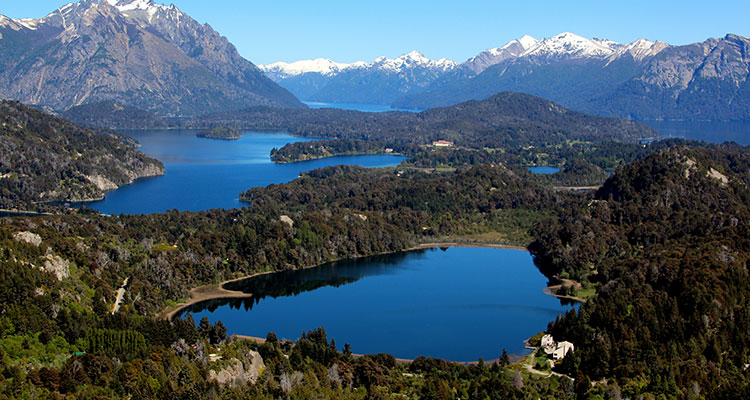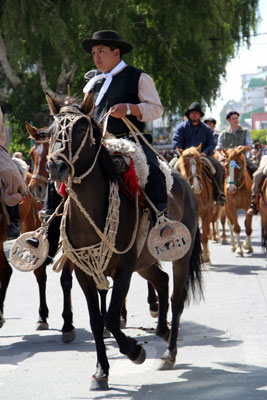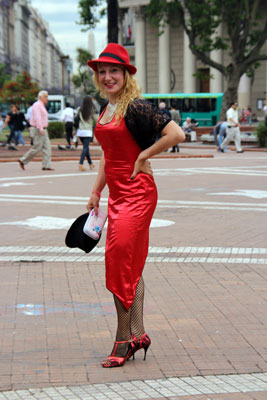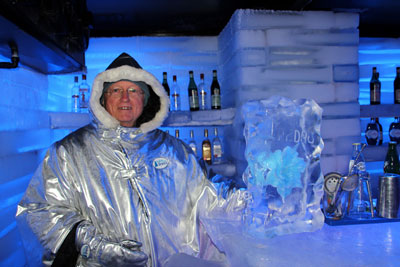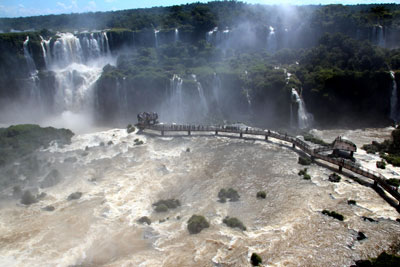From the Andes to Patagonia – dazzled by spectacular sights in Chile and Argentina
This article appears on page 6 of the January 2013 issue.
by Fred DeVinney; Oakland, CA
My wife, Jean, and I took the Overseas Adventure Travel (OAT) tour “Chile & Argentina: The Andes to Patagonia” plus their “Iguassu Falls Jungle Expedition” post-trip extension in November ’11. The visual splendor that we experienced was truly amazing! Add to that the wonderful diversity of activities and our superb guide Andrea Salas, who was continually looking for special and unique experiences, and you’ve got the recipe for an exceptional trip.
Beginning in Buenos Aires
We started in Buenos Aires, where we also spent time before and after our OAT tours. This gave us extra time on our own to explore and enjoy this attractive city, which is quite European in architecture and character.
Some of the highlights included the funky, colorful La Boca artists’ district; the Plaza de Mayo and the Casa Rosada; the extravagant Recoleta Cemetery, where Evita is buried; the splendid opera house with supposedly the best acoustics in the world; the Japanese gardens, and the restored waterfront area of Puerto Madero.
One night on our own, we enjoyed walking through the Puerto Madero and had a great steak at the highly recommended Las Lilas waterfront restaurant. We split a large steak, as the dinner came with many extras. Our meal for two, without drinks, cost about $70.
On another evening we attended the famous Carlos Gardel Tango Show, a superb show of music and dance preceded by an excellent multicourse dinner with unlimited wine. At $90 per person, this optional activity was worth it. (How could we travel to Buenos Aires for the first time and not experience the tango?!)
Bariloche
From Buenos Aires we flew to Esquel, as the Bariloche airport had been closed since the June ’11 volcanic eruption in Chile. (The resulting ash had continued to blow into the area quite frequently.) The scenic, 3-hour private bus ride to Bariloche, the Little Switzerland in the Andes, was well worth the slight inconvenience.
We checked in for three nights at the lovely Villa Huinid, featuring spacious rooms, an indoor pool, a gym, a spa and stunning views of Lake Nahuel Huapi backed by snowcapped mountains.
Our first full day brought clear blue skies and started with a horse ride (or a short, easy hike for the nonequestrians), followed by a chair-lift ride to the top of Campanario Hill. From there we took in the panoramic views of Patagonia’s striking scenery — deep-blue lakes and beautiful mountains in all directions.
Lunch followed at a family-owned craft brewery, with ample opportunity to sample some excellent homemade brews. After lunch, we relaxed with an optional float down the Limay River, taking in the local scenery and life.
Day two started with some informative interactions with the indigenous Mapuche people, followed by the annual gaucho parade in downtown Bariloche. What a colorful event and stroke of luck to be there at that time!
Two evenings and part of a day were free to experience Bariloche on our own. We enjoyed both a lunch and a dinner at the Familia Weiss, where we opted for lighter fare. Our excellent salads (seafood was the favorite) cost about $10 each.
Please note that we ate everything offered and drank tap water throughout our trip, as we were advised it was okay to do, without experiencing any problem.
On to Chile
From Bariloche we traveled by comfortable private bus to Chile and its coast, where a short ferry ride took us to the island of Chiloé.
Our first full day there was devoted to “a day in the life of Chiloé.” This was a nice touch, added by OAT to immerse travelers into the culture of the area.
Starting with a visit to a market — always a great way to observe and absorb the local culture — we viewed the unusual stilt houses along the river, visited unique wooden churches and walked around the central plaza of Castro before enjoying a home-hosted meal of curanto.
This traditional meal is cooked over a pit of hot rocks and features chicken, pork, sausage, mussels and clams. It was a fantastic feast, and I have never tasted better mussels!
The next day, a boat trip near the fishing village of Puñihuil provided up-close encounters with the local wildlife, the highlight for us being the cute little Humboldt and Magellanic penguins.
In the late afternoon we visited a school that the Grand Circle Foundation, the charity of the parent company of OAT, supports. There we experienced a heartwarming encounter with the children of this poor school with one lone teacher. The students’ mothers brought in homemade snacks, and the children performed a local dance. Our visit was very special.
Back on the mainland, it was a short ride to Puerto Varas, a very scenic, European-type resort town in the heart of Chile’s Lake District.
Many years ago I passed Mt. Fuji and was disappointed to find it totally enshrouded in fog, but the towering, majestic, snow-covered Osorno Volcano at the end of Lake Llanquihue, near Puerto Varas, wiped away any lingering disappointment of missing Fuji! To top that off, we were treated to a home-hosted trout lunch and an incredible view of this spectacular volcano.
Outdoor adventure
A short flight from the nearby Puerto Montt Airport took us to Punta Arenas, overlooking the Strait of Magellan. We had time for a walking tour of the central area before visiting a very impressive, recently completed replica of Magellan’s ship, situated on the edge of town.
The next day we traveled about five hours by private bus to Torres del Paine, considered by many to be Latin America’s finest nature park. The stunning scenery we experienced over the next two days was a highlight of the whole trip.
Our hotel was the lovely Hostería Lago Grey, on the edge of Lago Grey. The lake, with its magnificent glacier and ethereal-blue icebergs, was backed by jagged snowcapped mountain peaks. What a setting!
Over the next two days we hiked and explored this amazing area, with one hike taking us in for a close-up view of the towering peaks. Another highlight was a boat trip on Lago Grey to the glacier at the far end of the lake. En route, we passed icebergs that were like artistic sculptures in striking blue and white hues.
We topped it all off with pisco sours on deck made with real glacial ice. It was quite cold and windy, so we were thankful we had packed enough layers of clothing, including jackets, gloves and stocking caps.
In addition to the splendid scenery, Torres del Paine is abundant with many varieties of birds as well as a large number of guanaco, a relative of the llama and camel, roaming the park.
Back to Argentina
Upon leaving Torres del Paine, we traveled by private bus back into Argentina to El Calafate. We had two evenings on our own in this charming little town and time to enjoy the ambiance and setting of the Kau Yatún Hotel.
Los Glaciares National Park, a UNESCO World Heritage Site, was just a short drive away. Views of the world’s third-largest glacier can be seen along an extensive set of walkways, allowing visitors to experience it from many different vantage points.
Rising 200 feet at water’s edge and stretching as far back as the eye can see, it was truly an awesome sight.
On our way to the glacier, we were treated to a wonderful aerial show of Andean condors, crested caracara and black-chested buzzard-eagles. On our return, some of us stopped at a newly opened ice bar on the edge of town. Everything, including the walls, floor, bar, chairs and sculptures, was made of ice, yet we were warm with the parkas, gloves and boots they provided. We had a great time, and it certainly was a unique experience.
After a flight back to Buenos Aires, we all gathered for a final banquet in the newly restored Puerto Madero area. There was Argentinean beef, of course, for the carnivores, but other options were available, as they were throughout the trip.
Iguassu Falls
We said farewell to some of the new friends we had made; fortunately, half of us were continuing on with the extension to Iguassu Falls.
Although it was a close call, I do think we may have saved the best for last! It got off to a rocky start, as our Iguassu flight was canceled, but Andrea was on the hotline to OAT before others could rush the desk, and within minutes we were booked for the next day.
She then rebooked us into our previous night’s hotel, arranged an afternoon river trip through Tigre on the edge of Buenos Aires and booked a dinner for that night. Everything was also rearranged on the extension, so nothing was missed. Very impressive!
Upon our arrival at Iguassu airport, we headed to Yacutinga Lodge, with spacious individual cabins in a tropical setting, a beautiful, artistically decorated central lodge and excellent meals for a 2-night stay. From glaciers to jungle in two days!
Guided nature walks enhanced our appreciation for the plant and animal life within this dense tropical ecosystem. An optional kayak trip, time to relax and enjoy a swim and the presence of very few mosquitoes all added to our enjoyment.
The outstanding American Portal del Iguazú near the Argentinean side of Iguassu Falls was our home for the next two nights. We were upgraded to rooms overlooking the large pool complex at the intersection of two rivers, with Brazil on one side and Paraguay on the other. The restaurant was very good, and local musicians provided entertainment in the evening.
Nothing had prepared us for the immensity and stunning grandeur of this amazing labyrinth of falls, with enormous, billowing cascades of water as far as the eye could see!
Over two days we explored Iguassu from both the Brazilian and Argentinean sides. Both countries have set up extensive sets of walkways and viewing areas over, under and around the falls, where you experience the roaring sounds and heavy mist emanating from these rushing cliffs of water. It’s a photographer’s paradise.
To cap it all off, we took the optional Zodiac ride close to some of the more spectacular falls. The boat wound up the Iguassu River Canyon past a number of falls, culminating in a breathtaking look straight up into Devil’s Throat, the largest and most impressive of the falls in this vast network. While everyone got soaking wet (plastic bags were provided for cameras, etc.), it was hot out, so it was totally refreshing. A fitting climax to an extraordinary trip.
For the 17-day base trip, the 2013 price ranges from $3,995 to $4,395 per person, sharing, plus $1,695 for the 5-day Iguassu extension. Single supplements tend to be quite low, currently as low as $195 on the base trip. These prices include all internal flights but not international air.
We used bonus miles for our round-trip flight to Buenos Aires, but OAT can arrange international flights and they tend to cost less than what is otherwise available to individuals. The maximum number of travelers per trip is 16.

